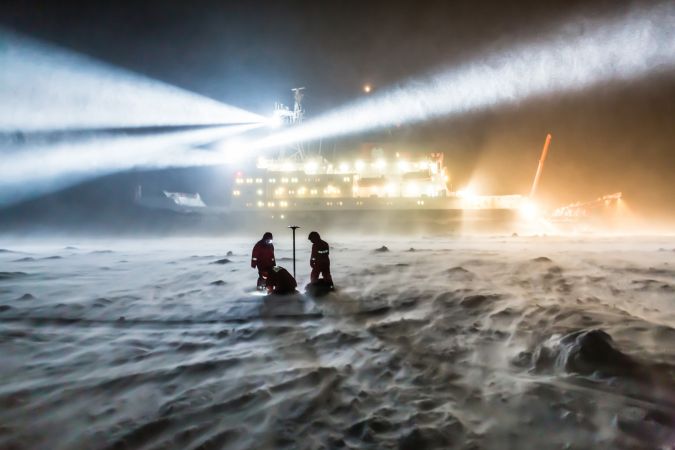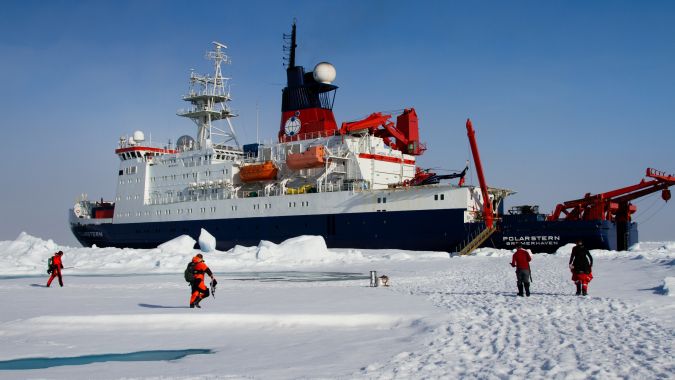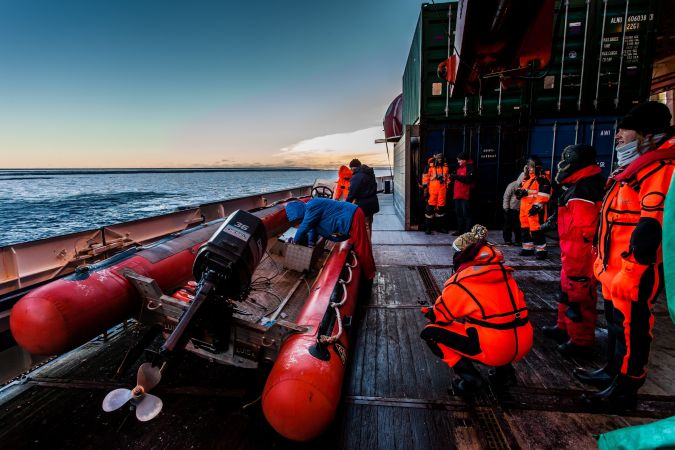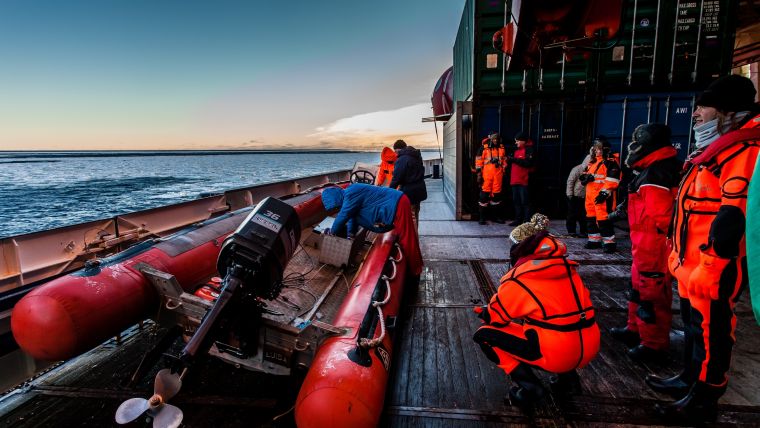600 Researchers to Spend a Whole Year Trapped in the Ice
The Biggest Arctic Expedition of All Time?
On 20 September 2019, the German research icebreaker Polarstern left Tromsø, Norway, for what could be the biggest Arctic research expedition of all time. Once she reaches the destination, the ship and her crew will become trapped in the ice and spend an entire year drifting through the Arctic Ocean.
Over 600 scientists and surveyors from 19 countries are on board Polarstern for the MOSAiC expedition, and several times that number of researchers will subsequently use the data gathered in further climate and ecosystem research. The mission is being spearheaded by the German Alfred Wegener Institute, Helmholtz Centre for Polar and Marine Research (AWI). More than 70 institutes have pooled their resources in a research consortium, resulting in an expedition budget of over €120 million. The purpose of the MOSAiC expedition is to conduct studies at a major long-term monitoring station in the Arctic: the AWI’s Hausgarten observatory in the Fram Strait. There, experts from various disciplines are investigating all aspects of the ecosystem, from the water’s surface to the ocean depths, in order to determine the impacts of climate change on biodiversity in the Arctic.
Hard Times in the Arctic
Struggling on the sea ice off Alaska during their training in April 2019, the participants of the MOSAiC expedition got a taste of how tough their task will be. They could steel themselves for the hard times that lie ahead in the Arctic: profound isolation and protracted darkness, laborious experiments, temperatures that can plunge to minus 45 ⁰C. There are countless ways the Arctic might thwart and threaten them at every turn, according to a journalist of the US newspaper The Washington Post. “But if we can do this right,” Melinda Webster, a participating sea ice expert at NASA’s Goddard Space Flight Center told the reporter, “it’s going to give us a huge leap forward in our understanding of Earth and how it’s changing.” Shoulders scrunched, beards of frost forming on their balaclavas, she and her colleagues will collect what information they can. They will have no choice but to keep going, Webster said in the report. The world attempts an expedition of this size, expense and risk only “once in a generation” – and hers might be the last generation that can do it.

Unique Expedition
The first-ever drift expedition dates back 125 years, when Fridtjof Nansen departed on board his sailing ship Fram. But there has never been an expedition like the one currently underway. For the first time, MOSAiC will take a modern research icebreaker brimming with cutting-edge scientific instrumentation close to the North Pole in winter. Four additional icebreakers will provide logistical support, and a dedicated landing strip will be created for use by resupply flights and two research aircraft. Helicopters, snowcats and snowmobiles will also be used.
This elaborate polar mission is necessary in order to gather data on the region – which is virtually inaccessible in winter – that is urgently needed for climate research. Although the Arctic regions have a tremendous influence on our climate, that influence remains poorly understood. The expedition’s data will offer new insights into the interactions between the ocean, ice and the atmosphere.
Drifting Sea Ice
During the MOSAiC expedition, the drifting sea ice alone will determine the research icebreaker Polarstern’s route just beyond the Arctic Circle. Icebreakers from Russia, China and Sweden will visit the ice floe to provide the expedition with fuel and exchange personnel. “An undertaking of this scale can only succeed through international collaboration,” explains Professor Antje Boetius, director of the AWI. A network of research camps will be formed on the 1.5-metre-thick floe surrounding Polarstern. There, the various teams will set up monitoring points to investigate the ocean, ice and atmosphere, as well as life in the Arctic winter.
“What happens in the Arctic doesn’t stay in the Arctic. The climate development in our latitudes greatly depends on what weather the Arctic ‘cooks up’. We now need to take a closer look, and explore the interactions between the atmosphere, ice and ocean there,” says Professor Markus Rex, head of Atmospheric Research at AWI as well as expedition head and coordinator of the MOSAiC project. Gauging the major project’s significance, Boetius adds, “The polar night in the Arctic plays a pivotal role for the adaptation of life forms; as such, we also expect to gain wholly new biological insights.” The expedition has five focus areas: the physics of sea ice and snow cover, atmospheric processes, ocean processes, biogeochemical cycles, and the ecosystem of the Arctic.

Early Warning System
The Arctic is generally considered to be an early warning system for climate change. The dark water absorbs more energy than the ice, which reflects solar radiation, and thanks to the thinner ice, more heat is making its way from the comparatively warm ocean to the surface and into the atmosphere. As a result, feedback effects are significantly amplifying the warming of the Arctic. But further observations are needed to grasp the interrelations between individual processes in the ocean, sea ice and atmosphere, and to quantify them in climate models.
“The dramatic scale of Arctic warming isn’t adequately reflected in today’s climate models, and the uncertainties in climate prognoses for the Arctic are enormous,” says Professor Rex with regard to the remaining gaps. “That’s why we have to comprehensively study the processes involved in the climate system, especially in the winter.” The effects of what transpires in the Arctic can already be felt in Europe, Asia and North America; the smaller differences in temperature between the Arctic and the Tropics are destabilizing the typical atmospheric pressure patterns. As a result, cold polar air is finding its way to the moderate latitudes, while warm, moist air is pushing into the Central Arctic and increasingly accelerating the warming.
Organisms living in the dark ocean depths rely on the sun-filled surface, where phytoplankton can grow, for food. In this regard, there are major fluctuations between warm and cold years. Accordingly, an interdisciplinary team of researchers – led by Chief scientist Dr Katja Metfies from the AWI, Helmholtz Centre for Polar and Marine Research – will comprehensively investigate the marine ecosystem in the survey area: from the atmosphere to the water column to the ocean floor. The marginal ice zone has proven to be especially productive in the context of long-term research conducted at the AWI’s Hausgarten observatory (which is located between Svalbard and Greenland).
UAV Paul
The researchers surmise that the high biological productivity there is the result of physical and chemical processes in the upper water column, as well as exchanges with the atmosphere. To examine the connections between physics, chemistry and ecology in the front systems of the marginal ice zone in detail, they use an autonomous underwater vehicle (AUV) named Paul. It not only records fundamental physical parameters (temperature, salinity, depth), but also various types of ecological data – including Chlorophyll A as an indicator of photosynthesis as well as organic substances and nutrients such as nitrate.
In previous expeditions Paul remained in the upper water layers, but it is now set to dive to the ocean floor. Equipped with a camera and sidescan sonar, its task is to map the seafloor in high resolution. Its sonar will expand the spatial coverage offered by the AWI’s towed camera system OFOS, because it can scan farther from side to side instead of simply ‘looking’ straight down. At depths down to 2,600 metres, Paul will hover five metres above the seafloor, recording its characteristics in approx. 10-15cm resolution. Those maps will then provide the basis for determining the sample collection sites for the ‘multicorer’, a device that extracts samples from the sediment for microbiological testing.
That sediment will pave the way for studies supplementing the microbiologists’ year-round investigations with the help of an autonomous tracked vehicle (‘crawler’). The AWI’s crawler, Tramper, is now rounding off its third full year spent exploring the Arctic seafloor, where it regularly measures things like oxygen consumption as an indicator of microbiological activity. During the current Polarstern expedition, the crawler will be retrieved and immediately prepared for its next mission. Tramper will be supported by a second crawler named Nomad, which was successfully tested at the deep-sea observatory in 2018. This time, the two robots will be equipped for a two-year operation, since Polarstern will not be available for an expedition to Hausgarten next year.
This article has been produced in collaboration with the Alfred Wegener Institute, Germany.

About the Alfred Wegener Institute (AWI)
The AWI is named after the German polar explorer Alfred Wegener, who discovered the continental drift. The institute was first launched in 1980 with only a handful of employees, but since then that number has risen to more than a thousand. The AWI is a foundation under public law and member of the Helmholtz Association – the largest scientific organization in Germany. In addition to its base in Bremerhaven, it also has facilities in Potsdam, on Helgoland and in List on the isle of Sylt. As the Helmholtz Centre for Polar and Marine Research, the institute is primarily active in the cold and temperate regions of the world. Working together with numerous national and international partners, the centre is involved in unravelling the complex processes at work in the Earth system.

Value staying current with hydrography?
Stay on the map with our expertly curated newsletters.
We provide educational insights, industry updates, and inspiring stories from the world of hydrography to help you learn, grow, and navigate your field with confidence. Don't miss out - subscribe today and ensure you're always informed, educated, and inspired by the latest in hydrographic technology and research.
Choose your newsletter(s)
























